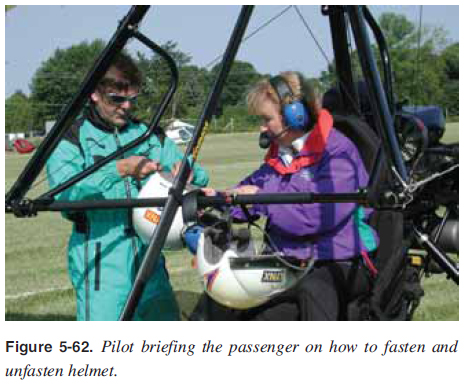| CHAPTER 5. Prefl ight and Ground Operations
Ready Aircraft To Enter Flight Deck
Either before or after the routine prefl ight inspection, the
aircraft should be unsecured, positioned for starting, and
readied to enter the fl ight deck. A checklist provides the
basic steps.
- Untie aircraft, secure tie down ropes in aircraft, or coil
neatly if they stay at airport.
- Remove ground chocks and secure in aircraft.
- Locate a suitable area to start engine that is free of dirt
and has minimal dust, preferably a paved or grassy
area away from people and objects.
Position aircraft so prop blast is clear; verify that
brakes are on, throttle is closed, and propeller area is
cleared.
- Position into wind, if possible, for best cooling during
warm up.
Occupant Prefl ight Brief
A prefl ight briefi ng is required to ensure the passenger is
informed on the proper use of safety equipment and exit
information. This can be done before entering the aircraft, and must be accomplished before starting the engine.
Manufacturers of S-LSA aircraft typically have printed
briefing cards that should be used. The following is a
comprehensive checklist that can be used as a guideline for
any prefl ight briefi ng:
- Seat belt fasten and unfasten procedures. Seat belts
must be worn for takeoff and landing (and should
always be worn during fl ight).
- What passengers can hold onto and what not to
touch.
- Positive exchange of controls using a three step
process : “You take the controls,” “I have the controls,”
“You have the controls.”
- Look for other ground and air traffi c.
- Flight deck entrance and exit procedures including
emergency exit.
- Ballistic parachute operation procedures.
- Engine-out situation and procedures for planned fl ight
with diversions.
- Hand signals in case electric loads must be shut off
or internal aircraft communications not functioning.
- Water landings with engine-out situation, if planned
fl ight over water.
- Ensure nothing can fall out of pockets while in fl ight.
This is especially important since the propeller is in
back.
- Helmet fastening and unfastening procedure.
[Figure 5-62]
- Review the type of aircraft (special or experimental)
which is not an FAA certified standard category
aircraft.
- Fire extinguisher operation, if so equipped.
- All safety systems, as required.
- Use restroom before entering aircraft.
|


